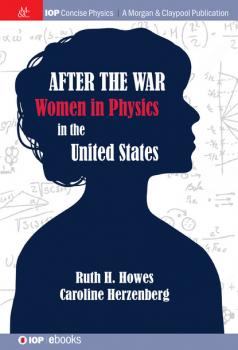IOP Concise Physics
Скачать книги из серии IOP Concise PhysicsAn Introduction to the Formalism of Quantum Information with Continuous Variables
Quantum information is an emerging field which has attracted a lot of attention in the last couple of decades. It is a broad subject which extends from the most applied questions (e.g. how to build quantum computers or secure cryptographic systems) to the most theoretical problems concerning the formalism and interpretation of quantum mechanics, its complexity, and its potential to go beyond classical physics. This book is an introduction to quantum information with special emphasis on continuous-variable systems (such as light) which can be described as collections of harmonic oscillators. It covers a selection of basic concepts, focusing on their physical meaning and mathematical treatment. It starts from the very first principles of quantum mechanics, and builds up the concepts and techniques following a logical progression. This is an excellent reference for students with a full semester of standard quantum mechanics and researchers in closely related fields.
Capture and Relaxation in Self-Assembled Semiconductor Quantum Dots
This is an overview of different models and mechanisms developed to describe the capture and relaxation of carriers in quantum-dot systems. Despite their undisputed importance, the mechanisms leading to population and energy exchanges between a quantum dot and its environment are not yet fully understood. The authors develop a first-order approach to such effects, using elementary quantum mechanics and an introduction to the physics of semiconductors. The book results from a series of lectures given by the authors at the Master’s level.
Lectures on Selected Topics in Mathematical Physics
This volume is a basic introduction to certain aspects of elliptic functions and elliptic integrals. Primarily, the elliptic functions stand out as closed solutions to a class of physical and geometrical problems giving rise to nonlinear differential equations. While these nonlinear equations may not be the types of greatest interest currently, the fact that they are solvable exactly in terms of functions about which much is known makes up for this. The elliptic functions of Jacobi, or equivalently the Weierstrass elliptic functions, inhabit the literature on current problems in condensed matter and statistical physics, on solitons and conformal representations, and all sorts of famous problems in classical mechanics. The lectures on elliptic functions have evolved as part of the first semester of a course on theoretical and mathematical methods given to first and second year graduate students in physics and chemistry at the University of North Dakota. They are for graduate students or for researchers who want an elementary introduction to the subject that nevertheless leaves them with enough of the details to address real problems. The style is supposed to be informal. The intention is to introduce the subject as a moderate extension of ordinary trigonometry in which the reference circle is replaced by an ellipse. This entre depends upon fewer tools and has seemed less intimidating that other typical introductions to the subject that depend on some knowledge of complex variables. The first three lectures assume only calculus, including the chain rule and elementary knowledge of differential equations. In the later lectures, the complex analytic properties are introduced naturally so that a more complete study becomes possible.
Order from Force
The present theme concerns the forces of nature, and what investigations of these forces can tell us about the world we see about us. The story of these forces is long and complex, and contains many episodes that are not atypical of the bulk of scientific research, which could have achieved greater acclaim 'if only…'. The intention of this book is to introduce ideas of how the visible world, and those parts of it that we cannot observe, either because they are too small or too large for our scale of perception, can be understood by consideration of only a few fundamental forces. The subject in these pages will be the authority of the commonly termed, laws of physics, which arise from the forces of nature, and the corresponding constants of nature (for example, the speed of light, c, the charge of the electron, e, or the mass of the electron, me).
Elementary Cosmology
Cosmology is the study of the origin, size, and evolution of the entire universe. Every culture has developed a cosmology, whether it be based on religious, philosophical, or scientific principles. In this book, the evolution of the scientific understanding of the Universe in Western tradition is traced from the early Greek philosophers to the most modern 21st century view. After a brief introduction to the concept of the scientific method, the first part of the book describes the way in which detailed observations of the Universe, first with the naked eye and later with increasingly complex modern instruments, ultimately led to the development of the «Big Bang» theory. The second part of the book traces the evolution of the Big Bang including the very recent observation that the expansion of the Universe is itself accelerating with time.
Smart Internal Stimulus-Responsive Nanocarriers for Drug and Gene Delivery
The concept of smart drug delivery vehicles involves designing and preparing a nanostructure (or microstructure) that can be loaded with a cargo. This can be a therapeutic drug, a contrast agent for imaging, or a nucleic acid for gene therapy. The nanocarrier serves to protect the cargo from degradation by enzymes in the body, to enhance the solubility of insoluble drugs, to extend the circulation half-life, and to enhance its penetration and accumulation at the target site. Importantly, smart nanocarriers can be designed to be responsive to a specific stimulus, so that the cargo is only released or activated when desired. In this volume we cover smart nanocarriers that respond to internal stimuli that are intrinsic to the target site. These stimuli are specific to the cell type, tissue or organ type, or to the disease state (cancer, infection, inflammation etc). pH-responsive nanostructures can be used for cargo release in acidic endosomal compartments, in the lower pH of tumors, and for specific oral delivery either to the stomach or intestine. Nanocarriers can be designed to be substrates of a wide-range of enzymes that are over-expressed at disease sites. Oxidation and reduction reactions can be taken advantage of in smart nanocarriers by judicious molecular design. Likewise, nanocarriers can be designed to respond to a range of specific biomolecules that may occur at the target site. In this volume we also cover dual and multi-responsive systems that combine stimuli that could be either internal or external.
Smart External Stimulus-Responsive Nanocarriers for Drug and Gene Delivery
The concept of smart drug delivery vehicles involves designing and preparing a nanostructure (or microstructure) that can be loaded with a cargo, this can be a therapeutic drug, a contrast agent for imaging, or a nucleic acid for gene therapy. The nanocarrier serves to protect the cargo from degradation by enzymes in the body, to enhance the solubility of insoluble drugs, to extend the circulation half-life, and to enhance its penetration and accumulation at the target site. Importantly, smart nanocarriers can be designed to be responsive to a specific stimulus, so that the cargo is only released or activated when desired. In this volume we cover smart nanocarriers that respond to externally applied stimuli that usually involve application of physical energy. This physical energy can be applied from outside the body and can either cause cargo release, or can activate the nanostructure to be cytotoxic, or both. The stimuli covered include light of various wavelengths (ultraviolet, visible or infrared), temperature (increased or decreased), magnetic fields (used to externally manipulate nanostructures and to activate them), ultrasound, and electrical and mechanical forces. Finally we discuss the issue of nanotoxicology and the future scope of the field.
Structure and Evolution of Single Stars
Structure and Evolution of Single Stars: An introduction is intended for upper-level undergraduates and beginning graduates with a background in physics. Following a brief overview of the background observational material, the basic equations describing the structure and evolution of single stars are derived. The relevant physical processes, which include the equation of state, opacity, nuclear reactions and neutrino losses are then reviewed. Subsequent chapters describe the evolution of low-mass stars from formation to the final white dwarf phase. The final chapter deals with the evolution of massive stars.
Computation in Science
This book provides a theoretical background in computation to scientists who use computational methods. It explains how computing is used in the natural sciences, and provides a high-level overview of those aspects of computer science and software engineering that are most relevant for computational science. The focus is on concepts, results, and applications, rather than on proofs and derivations. The unique feature of this book is that it “connects the dots between computational science, the theory of computation and information, and software engineering. The book should help scientists to better understand how they use computers in their work, and to better understand how computers work. It is meant to compensate a bit for the general lack of any formal training in computer science and information theory. Readers will learn something they can use throughout their careers.
After the War
This book examines the lives and contributions of American women physicists who were active in the years following World War II, during the middle decades of the 20th century. It covers the strategies they used to survive and thrive in a time where their gender was against them. The percentage of PhD’s in physics has risen for 6% in 1983 to 20% in 2012 (an all-time high for women). By understanding the history of women in physics, these gains can continue. It discusses to major classes of women physicists; those who worked on military projects, and those who worked in industrial laboratories and at universities largely in the late 1940s and 1950s. While it includes minimal discussion of physics and physicists in the 1960s and later, this book focuses on the challenges and successes of women physicists in the years immediately following World War II and before the eras of affirmative actions and the use of the personal computer.









